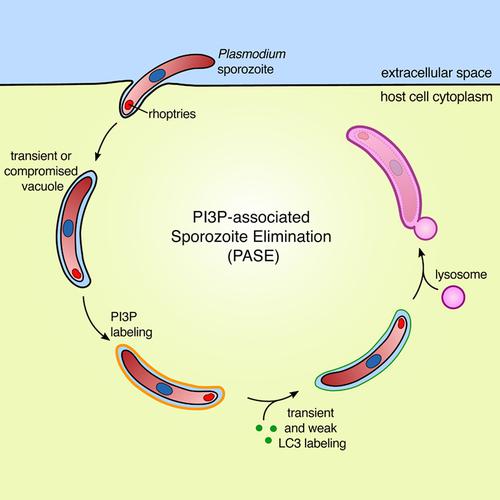当前位置:
X-MOL 学术
›
Cell. Microbiol.
›
论文详情
Our official English website, www.x-mol.net, welcomes your
feedback! (Note: you will need to create a separate account there.)
Plasmodium berghei sporozoites in nonreplicative vacuoles are eliminated by a PI3P-mediated autophagy-independent pathway.
Cellular Microbiology ( IF 2.6 ) Pub Date : 2020-09-26 , DOI: 10.1111/cmi.13271 Annina Bindschedler 1, 2 , Rahel Wacker 1, 2 , Jessica Egli 1 , Nina Eickel 1, 2 , Jacqueline Schmuckli-Maurer 1 , Blandine M Franke-Fayard 3 , Chris J Janse 3 , Volker T Heussler 1
Cellular Microbiology ( IF 2.6 ) Pub Date : 2020-09-26 , DOI: 10.1111/cmi.13271 Annina Bindschedler 1, 2 , Rahel Wacker 1, 2 , Jessica Egli 1 , Nina Eickel 1, 2 , Jacqueline Schmuckli-Maurer 1 , Blandine M Franke-Fayard 3 , Chris J Janse 3 , Volker T Heussler 1
Affiliation

|
The protozoan parasite Plasmodium, causative agent of malaria, invades hepatocytes by invaginating the host cell plasma membrane and forming a parasitophorous vacuole membrane (PVM). Surrounded by this PVM, the parasite undergoes extensive replication. Parasites inside a PVM provoke the Plasmodium‐associated autophagy‐related (PAAR) response. This is characterised by a long‐lasting association of the autophagy marker protein LC3 with the PVM, which is not preceded by phosphatidylinositol 3‐phosphate (PI3P)‐labelling. Prior to productive invasion, sporozoites transmigrate several cells and here we describe that a proportion of traversing sporozoites become trapped in a transient traversal vacuole, provoking a host cell response that clearly differs from the PAAR response. These trapped sporozoites provoke PI3P‐labelling of the surrounding vacuolar membrane immediately after cell entry, followed by transient LC3‐labelling and elimination of the parasite by lysosomal acidification. Our data suggest that this PI3P response is not only restricted to sporozoites trapped during transmigration but also affects invaded parasites residing in a compromised vacuole. Thus, host cells can employ a pathway distinct from the previously described PAAR response to efficiently recognise and eliminate Plasmodium parasites.
中文翻译:

非复制性液泡中的伯氏疟原虫子孢子通过 PI3P 介导的自噬独立途径消除。
原生动物寄生虫疟原虫是疟疾的病原体,通过内陷宿主细胞质膜并形成寄生液泡膜 (PVM) 来侵入肝细胞。被这个 PVM 包围,寄生虫经历了广泛的复制。PVM 内的寄生虫会引发疟原虫相关自噬相关(PAAR)反应。这以自噬标记蛋白 LC3 与 PVM 的长期关联为特征,其之前没有磷脂酰肌醇 3-磷酸 (PI3P) 标记。在生产性入侵之前,子孢子会迁移几个细胞,在这里我们描述了一部分穿越子孢子被困在瞬态穿越液泡中,引发了明显不同于 PAAR 反应的宿主细胞反应。这些被捕获的子孢子在细胞进入后立即引起周围液泡膜的 PI3P 标记,然后是瞬时 LC3 标记并通过溶酶体酸化消除寄生虫。我们的数据表明,这种 PI3P 反应不仅限于在轮回过程中捕获的子孢子,而且还会影响居住在受损液泡中的入侵寄生虫。因此,宿主细胞可以采用不同于先前描述的 PAAR 反应的途径来有效识别和消除疟原虫。
更新日期:2020-09-26
中文翻译:

非复制性液泡中的伯氏疟原虫子孢子通过 PI3P 介导的自噬独立途径消除。
原生动物寄生虫疟原虫是疟疾的病原体,通过内陷宿主细胞质膜并形成寄生液泡膜 (PVM) 来侵入肝细胞。被这个 PVM 包围,寄生虫经历了广泛的复制。PVM 内的寄生虫会引发疟原虫相关自噬相关(PAAR)反应。这以自噬标记蛋白 LC3 与 PVM 的长期关联为特征,其之前没有磷脂酰肌醇 3-磷酸 (PI3P) 标记。在生产性入侵之前,子孢子会迁移几个细胞,在这里我们描述了一部分穿越子孢子被困在瞬态穿越液泡中,引发了明显不同于 PAAR 反应的宿主细胞反应。这些被捕获的子孢子在细胞进入后立即引起周围液泡膜的 PI3P 标记,然后是瞬时 LC3 标记并通过溶酶体酸化消除寄生虫。我们的数据表明,这种 PI3P 反应不仅限于在轮回过程中捕获的子孢子,而且还会影响居住在受损液泡中的入侵寄生虫。因此,宿主细胞可以采用不同于先前描述的 PAAR 反应的途径来有效识别和消除疟原虫。











































 京公网安备 11010802027423号
京公网安备 11010802027423号